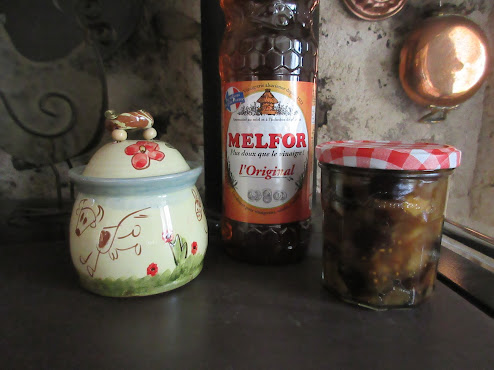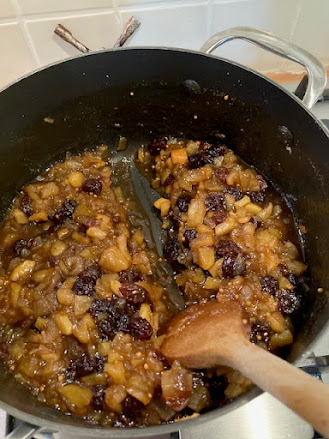Our tomatoes have started to ripen but although they taste delicious they would not win any beauty contest! They are a bit "noggly" - lumpy and bumpy with the odd split. With a pack of puff pastry in the freezer I decided to use some of them for little tarts.
There was also a selection of bits of cheese in the fridge - we call those "noggle ends" - bits you would put under the grill on toast or in a quiche. I used Camembert and something called Tome aux Fleurs, a hard cheese with a crust of flower petals, which you can read about here. Grated cheddar would have worked well.
Also lurking in the fridge was a small pack of cocktail frankfurters, purchased for some long forgotten event and never used but fortunately well within date.
I used my free Yorkshire pudding tin (see here) to make four tarts but this time used a slightly bigger template to cut the pastry allowing me to crimp the edges more neatly. (It's actually something I spotted in Ikea, is meant to be the base for one of those stainless steel kitchen tool holders and I had a hunch it would be just the right size.)
My pastry made four tarts and eight cocktail sausage rolls (recipe here) from the trimmings. All fun to make and very tasty - a nice way to entertain children on a wet afternoon in the school holidays I think - they are very adaptable and bake in just the right amount of time to clear up then heat up a tin of baked beans!😋
Ingredients
1 pack of ready made, ready rolled, oblong puff pastry
2 tsp French mustard (or brown sauce, onion chutney or ketchup if you prefer)
6 thick slices of tomato
Thin slices of any cheese you have (or grated cheddar if you prefer)
1 egg, beaten (optional but worth using if you are also making the sausage rolls)
Fresh or dried thyme
8 cocktail frankfurters (or one large frankfurter cut into bits or the filling from a sausage)
Method
Preheat the oven to 200°C / 180° fan / gas mk6. Grease the four holes of a Yorkshire pudding tin or four small tart tins (or use four ovenproof saucers placed on a baking sheet).
Allow the pastry to thaw and come up to room temperature. Unroll and cut four circles about 2cm bigger than the holes using anything you have that’s the right size as a template. Lay the pastry into the holes and crimp the edges.
Using the back of a teaspoon spread 1/2 tsp mustard over the base of each tart. Add the slices of tomato, cutting to fill the pastry. Arrange thin slices of cheese on top but leaving gaps as the cheese will melt and spread.
Brush the pastry edges with beaten egg (optional). Sprinkle with fresh or dried thyme and bake for 20 minutes until the pastry is crisp and golden brown and the cheese has melted and bubbled.
Use the pastry trimmings to make little sausage rolls which can go into the oven at the same time.
Makes 4 tarts and 8 cocktail sausage rolls























